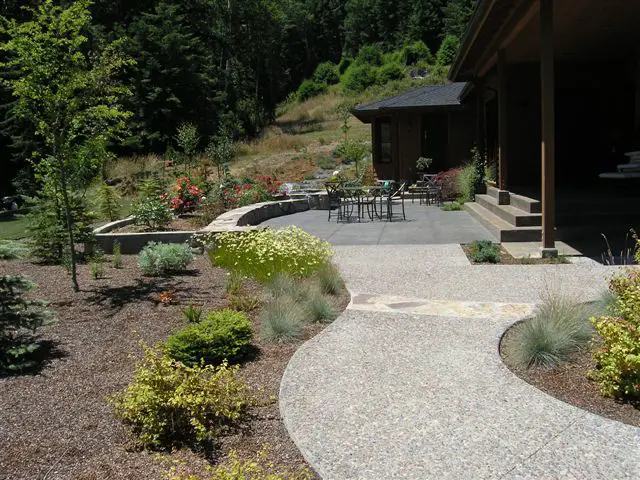
Exposed aggregate finish options
An exposed aggregate finish can be any type of aggregate that is left exposed in the final surface of the concrete.
Aggregate is just a fancy way of saying stone, pebble, rocks or sand.
How to Create an Exposed aggregate concrete surface finish.
1. Standard exposed aggregate: Aggregate is mixed into the concrete batch itself, whereas the surface aggregate will be a random placement of any of the type of aggregate that were originally mixed.
2. Topping aggregate: Another way of having a bit more control over the surface aggregate is by using a topping system. An initial concrete slab is poured to fill and build the base surface. Once dry a top layer or topping concrete usually averaging 1 1/2 -2″ inches thick is then poured on top of the first. This topping can be filled will specific aggregate and therefore give more control over the design and finish.
3. Seeded aggregate gives the most control over the surface aggregate. Seeding is done by placing or seeding the aggregate into the surface of the wet concrete. It gives a lot of control over the design of the finish, although for obvious reasons is much more labor intensive.This is a basic overview of how exposed aggregate finishes are achieved.
When ordering the concrete special measures should be taken to order concrete acceptable for exposed aggregate.
This means the aggregate shapes and sizes will be suitable for the desired finish. Then the basic concrete placing and finishing rules all apply. Once the concrete has been placed and finished, a surface set retarder is applied to the area where the exposed aggregate finish is desired.
Set retarders prevent the concrete from setting up or hardening. They are only applied to the surface therefore the concrete will set-up beneath the surface and grab on to the aggregate but the cement around the surface of the aggregate will remain soft and liquid. After a suitable amount of time has passed and the concrete is hardened, a hose or pressure washer with the aid of a stiff broom should be able to scrub and clean the soft cement residue off the surface.
And ‘voila’ exposed aggregate. Sealers are often used to protect and maintain the surface finish as well as deepen and bring out the colors of the exposed aggregate.
Other ways of creating or exposing aggregate, include, but are not limited to:
Abrasive blasting: This is where an abrasive, usually sand, is blasted at the surface of hardened concrete. The blasting exposes small sand and aggregate giving a rough surface texture similar to that of sand paper.
Acid etching: This is a chemical means by which an acid solution (Muriatic Acid & Water) is applied to the hardened concrete surface and etches or burns through the cement portion of the concrete. The aggregate usually the small sand bits are left exposed and give a similar look to that of a sand blasted finish.
Concrete grinding or polishing: Grinding removes the thin layer of cement paste and cuts the aggregates to a uniformly smooth surface resembling terrazzo. The surface can be a dull matte finish or, with the use of increasingly finer grinding pads, can reach a high luster.
